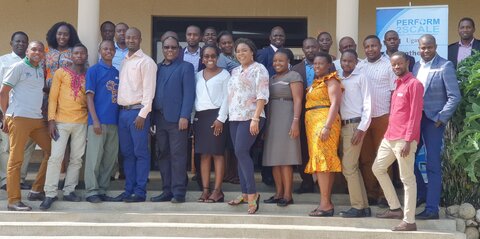PERFORM2Scale Research – Key findings

The following is a brief summary of the findings of the PERFORM2Scale intervention and its scale up in Ghana, Malawi and Uganda. These findings and others are also being presented through a number of academic papers, briefing papers, reports, webinars and presentations which are available through the resources section of this website. The Synthesis Report may be of particular interest along with the recording of our end-of-project webinar which summarised our work and heard from some of the participants.
The research questions upon which these findings are based can be found here.
Management Strengthening Intervention (MSI)
- The MSI is an effective intervention for management strengthening and can contribute to improved service delivery.
- Deepening of DHMT learning occurs through multiple cycles.
- It was confirmed that the intervention works despite – or even can benefit from – the absence of extra implementation funds, with DHMTs strengthening their management competencies to become more resourceful and responsive to local needs.
- The MSI provides opportunities for district managers to come together to share experiences, learn from each other and overcome challenges.
- It was possible to adapt the intervention to better fit with local needs and budget cycles and expand participation, such as the involvement of a wider group of district stakeholders in the MSI.
- The flexibility given to districts leads to different solutions and approaches. This in turn results in diverse patterns and situations making outcome monitoring challenging (eg in terms of service or health systems improvement).
Process evaluation – Scale-up
- It is possible to effect considerable scale-up of a complex intervention if the intervention is valued and funds are available for scale-up.
- However, scale-up is not a linear process. It is a bumpy road with advances and set-backs along the way, with a range of factors interacting to influence scale-up.
- Critical to successful vertical scale-up is having a clear, shared vision among the different stakeholders involved about how to institutionalise (components of) the intervention into existing systems. It takes times to develop this shared vision. Then this vision needs to be translated into a strategic plan for scale-up.
- Without vertical scale-up, horizontal scale-up will stagnate and vice versa.
- The ExpandNet approach, adapted for PERFORM2Scale, provides a good guide for scale-up, which needs to be flexible to the context and should be adapted as you go on the scale-up journey. Spending time to identify appropriate existing structures to carry out the role of adopting and implementing the intervention at a larger scale and avoid creating parallel structures is critical.
- Reappraisal of the need and demand for the intervention at an early stage, including a review of programmes with perceived similarities, should be included in the scale-up journey.
- Alignment of the intervention to existing policies and interests needs to be considered at the outset. This requires not only in-depth knowledge of the policy environment and relationships with key decision-makers, but also continuous or frequent observation and scanning of the horizon for windows of opportunity and new and important stakeholders.
- Evidence is needed to convince stakeholders about scale-up. Major efforts are needed to generate and disseminate convincing evidence. However, it is not only evidence that plays a role in convincing stakeholders of the value of the MSI scale-up. It also depends on the mandate and position of the stakeholders and how they are viewed by others.
- Critical to this is the identification of champions and supportive stakeholders to advocate for further funded scale-up to ensure maximum impact and sustainability of the intervention.
- Thinking and working politically is essential to identify and anticipate changes in power relationships between key stakeholders and decision-makers that would support or hinder scale-up.
Outcomes in the districts
Ghana
• Increases in Yaws and other NTD detection rates in Yilo Krobo. That team has also used the skills they’ve developed during the MSI to identify cases of COVID-19.
• The Suhum DHMT targeted low antenatal care attendance (ANC). They engaged with community members on social cultural norms and beliefs, improved service delivery by increasing outreach services, and trained staff on customer care and the patient charter to increase ANC coverage.
• In Fanteakwa, the DHMT focused on high institutional mortality by increasing low outpatient attendance rates. Poor staff performance, as well as poor health seeking behaviour, were tackled using different measures such as training in customer care, governance and leadership, introducing a facility-level attendance register, and setting up a disciplinary committee.
• All districts have experienced improvements in their management skills, team confidence and independence, and teamwork.
Malawi
• Ntchisi increased the number of managers who had developed workplans in the previous six months from 20% to 90%, with some departments achieving 100% completion rates.
• Salima increased health facility supervision (an identified cause of poor-quality service delivery) from <50% to 75%, and demonstrated increased team cohesion and coordination.
• In Dowa there is evidence that DHMTs’ lobbying and entrepreneurial skills have been enhanced, resulting in a dormant health facility being reopened and additional staff recruited.
• Improvements in the DHMTs’ management skills have been observed across the DHMTs, eg the Ntchisi team reports improvements in group working, confidence and empowerment.
Uganda
• Reduced absenteeism and improved provision of service in both Wakiso and Nakaseke districts.
• Improved TB cure rates in Luwero (20% in Dec 2017 to 63% by March 2019).
• Progress towards addressing low ante-natal clinic (ANC) attendance in Ntoroko district through increased community awareness and improved performance management.
• Steps to improve rates of fresh still births in Kabarole using strategies to increase ANC attendance and reduce labour complications through the provision of Emergency Obstetric Care based on early detection of complications. These strategies are being embedded into quality improvement projects at the district and facility levels.
• Increased confidence among staff and better teamwork and leadership performance.
• Improved coordination with stakeholders at district level.